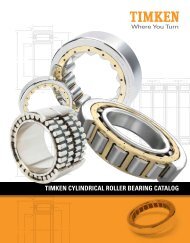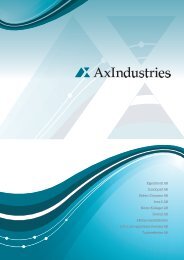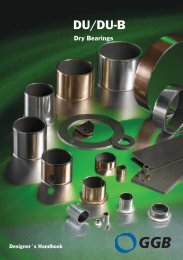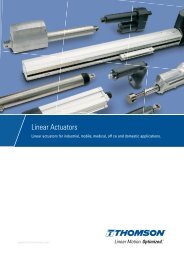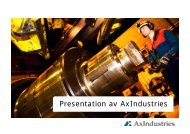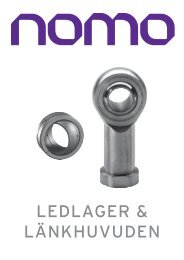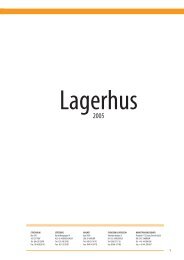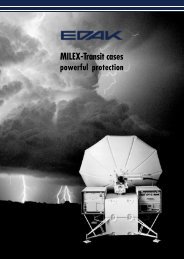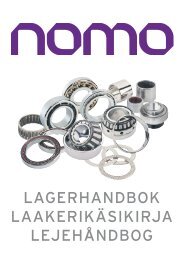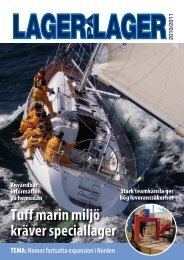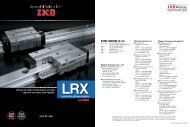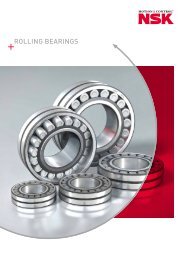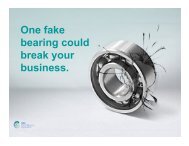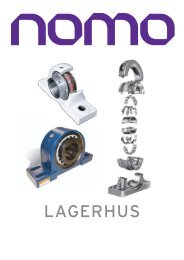Marginally lubricated
Marginally lubricated
Marginally lubricated
- No tags were found...
You also want an ePaper? Increase the reach of your titles
YUMPU automatically turns print PDFs into web optimized ePapers that Google loves.
DX<strong>Marginally</strong> <strong>lubricated</strong>Designer´s HandbookGGB
QualityAll the products described in this handbook are manufactured under DIN ISO 9001/2 or QS 9000 approved qualitymanagement systems.I
Formula Symbols and DesignationsFormulaSymbolUnitDesignationFormulaSymbolUnitDesignationa B - Bearing size factora E - High load factora Q - Speed/Load factora S - Surface finish factora T - Temperature application factorB mm Nominal bush widthC 1/min Dynamic load frequencyC D mm Installed diametral clearanceC Dm mm Diametral clearance machinedC T - Total number of dynamic load cyclesC i mm ID chamfer lengthC o mm OD chamfer lengthD H mm Housing DiameterD i mm Nominal bush/thrust washer IDD i,a mm Bush ID when assembled in housingD i,a,m mm Bush ID assembled and machinedD J mm Shaft diameterD o mm Nominal bush/thrust washer ODd D mm Dowel hole diameterd L mm Oil hole diameterd P mm Pitch circle diameter for dowel holeF N Bearing loadF i N Insertion forcef - frictionH a mm Depth of Housing Recess (e.g. for thrustwashers)H d mm Diameter of Housing Recess ( thrustwashers)p N/mm 2 Specific loadp lim N/mm 2 Specific load limitp sta,max N/mm 2 Maximum static loadp dyn,max N/mm 2 Maximum dynamic loadQ - Total number of cyclesR - Number of lubrication intervalsR a µm Surface roughness(DIN 4768, ISO/DIN 4287/1)s 3 mm Bush wall thicknesss S mm Strip thicknesss T mm Thrust washer thicknessT °C TemperatureT amb °C Ambient temperatureT max °C Maximum temperatureT min °C Minimum temperatureU m/s Sliding speedu - speed factorW mm Strip widthW u mm Maximum usable strip widthα 1 1/10 6 K Coefficient of linear thermal expansionparallel to surfaceα 2 1/10 6 K Coefficient of linear thermal expansionnormal to surfaceσ c N/mm 2 Compressive Yield strengthλ W/mK Thermal conductivityϕ ° Angular displacementη Ns/mm 2 Dynamic ViscosityZ T - Total number of osscillating movementsL mm Strip lengthL H h Bearing service lifeL RG h Relubrication intervalN 1/min Rotational speedN osz 1/min Oscillating movement frequencyII
ContentContentQuality . . . . . . . . . . . . . . . . . . . . . IFormula Symbols andDesignations . . . . . . . . . . . . . . . . II1 Introduction . . . . . . . . . . . 41.1 Characteristics and Advantages 42 Structure . . . . . . . . . . . . . 52.1 Basic Forms . . . . . . . . . . . . . . . . 53 Properties . . . . . . . . . . . . . 63.1 Physical Properties . . . . . . . . . . 63.2 Chemical Properties . . . . . . . . . 64 Lubrication . . . . . . . . . . . . 74.1 Choice of Lubricant . . . . . . . . . . 74.2 Friction . . . . . . . . . . . . . . . . . . . . 94.3 Lubricated Environments . . . . . 9Lubrication . . . . . . . . . . . . . . . . . . 94.4 Characteristics of FluidLubricated DX Bearings . . . . . 104.5 Design Guidance for FluidLubricated Applications . . . . . 104.6 Wear Rate and RelubricationIntervals with Greaselubrication . . . . . . . . . . . . . . . . 12Fretting Wear . . . . . . . . . . . . . . . 125 Design Factors . . . . . . . 135.1 Specific Load . . . . . . . . . . . . . . 13Specific Load Limit . . . . . . . . . . . 135.2 Sliding Speed . . . . . . . . . . . . . . 14Continuous Rotation . . . . . . . . . 14Oscillating Movement . . . . . . . . 145.3 pU Factor . . . . . . . . . . . . . . . . . 155.4 Load . . . . . . . . . . . . . . . . . . . . . 15Type of Load . . . . . . . . . . . . . . . 155.5 Temperature . . . . . . . . . . . . . . . 175.6 Mating Surface . . . . . . . . . . . . . 175.7 Bearing Size . . . . . . . . . . . . . . . 185.8 Estimation of Bearing ServiceLife with Grease Lubrication . 18Calculation Parameters . . . . . . . 18Estimate Bearing Life . . . . . . . . . 19Estimate Re-greasing Interval . . 19Oscillating Motion . . . . . . . . . . . 19Dynamic Loads . . . . . . . . . . . . . 195.9 Worked Examples . . . . . . . . . . 206 Data Sheet . . . . . . . . . . . 216.1 Data for bearing designcalculations . . . . . . . . . . . . . . . 217 Bearing Assembly . . . . . 227.1 Dimensions and Tolerances . . 227.2 Tolerances for minimumclearance . . . . . . . . . . . . . . . . . . 22Grease lubrication . . . . . . . . . . . 22Fluid Lubrication . . . . . . . . . . . . . 24Allowance for ThermalExpansion . . . . . . . . . . . . . . . . . 247.3 Counterface Design . . . . . . . . . 257.4 Installation . . . . . . . . . . . . . . . . 26Fitting of Bushes . . . . . . . . . . . . 26Insertion Forces . . . . . . . . . . . . . 26Alignment . . . . . . . . . . . . . . . . . . 27Sealing . . . . . . . . . . . . . . . . . . . . 27Axial Location . . . . . . . . . . . . . . . 27Fitting of Thrust Washers . . . . . . 27Slideways . . . . . . . . . . . . . . . . . . 288 Machining . . . . . . . . . . . 298.1 Machining Practice . . . . . . . . . 298.2 Boring . . . . . . . . . . . . . . . . . . . . 298.3 Reaming . . . . . . . . . . . . . . . . . . 308.4 Broaching . . . . . . . . . . . . . . . . . 308.5 Vibrobroaching . . . . . . . . . . . . . 318.6 Modification of components . . 318.7 Drilling Oil Holes . . . . . . . . . . . 318.8 Cutting Strip Material . . . . . . . . 319 Electroplating . . . . . . . . 32DX Components . . . . . . . . . . . . . 32Mating Surfaces . . . . . . . . . . . . . 3210 Standard Products . . . . 3310.1 PM-DX cylindrical bushes . . . . 3310.2 MB-DX cylindrical bushes . . . . 4010.3 Inch DX cylindrical bushes . . . 4510.4 DX Thrust Washers - metric . . 4810.5 DX Thrust Washers - inch . . . . 4910.6 DX Strip - metric . . . . . . . . . . . . 5010.7 DX Strip - inch . . . . . . . . . . . . . 503
1 Introduction1 IntroductionThe purpose of this handbook is to providecomprehensive technical information onthe characteristics of DX bearings. Theinformation given, permits designers toestablish the correct size of bearingrequired and the expected life and performance.GGB Research and Developmentservices are available to assist withunusual design problems.Complete information on the range of DXstandard stock products is given togetherwith details of other DX products.GGB is continually refining and extendingits experimental and theoretical knowledgeand, therefore, when using this brochure itis always worthwhile to contact the Companyshould additional information berequired.Customers are advised to carry out prototypetesting wherever possible.1.1 Characteristics and Advantages• DX provides maintenance free operation• DX has a high pU capability• DX exhibits low wear rate• Seizure resistant• Suitable for temperatures from -40 to+120 °C• High static and dynamic load capacity• Good frictional properties• No water absorption and thereforedimensionally stable• Compact and light• Suitable for rotating, oscillating, reciprocatingand sliding movements• DX bearings are prefinished andrequire no machining after assembly2 StructureDX is a composite bearing material developedspecifically to operate with marginallubrication and consists of three bondedlayers: a steel backing strip and a sinteredporous bronze matrix, impregnated andoverlaid with a pigmented acetal copolymerbearing material.The steel backing provides mechanicalstrength and the bronze interlayer providesa strong mechanical bond for the lining.This construction promotes dimensionalstability and improves thermal conductivity,thus reducing the temperature at the bearingsurface.DX is designed for use with grease lubricationand the bearing surface is normallyprovided with a uniform pattern of indentsThese serve as a reservoir for the greaseand are designed to provide the optimumdistribution of the lubricant over the bearingsurface.Fig. 1:DX-microsection4
Structure22.1 Basic FormsStandard Components available from stockThese products are manufactured to International,National or GGB standarddesigns.Metric and Imperial Sizes• Cylindrical Bushes- PM pre finished metric range, notmachinable in situ, for use with standardjournals finished to h6-h8 limits.- MB machinable metric range, with anallowance for machining in situ.- Machinable inch range for use as suppliedor after machining in situ.• Thrust Washers• Strip MaterialFig. 2:Standard componentsNon Standard Components not available from stockThese products are manufactured to customers’requirements with or without GGBrecommendations, and include for example• Modified Standard Components• Half Bearings• Flat Components• Pressings• StampingsFig. 3:Non standard components5
3 Properties3 Properties3.1 Physical PropertiesPhysicalPropertiesCharacteristic Symbol Value DX Unit CommentsThermal Conductivity λ 52 W/mKCoefficient of linear thermal expansion :parallel to surface α 1 11 1/10 6 Knormal to surface α 2 29 1/10 6 KMechanicalPropertiesMaximum Operating Temperature T max 120 °CMinimum Operating Temperature T min –40 °CCompressive Yield Strength σ c 380 N/mm 2 measured on disc 5 mm diameterx 2.45 mm thick.Maximum LoadStatic p sta,max 140 N/mm 2Dynamic p dyn,max 140 N/mm 2ElectricalPropertiesVolume resistivity of acetal lining 10 15 ΩcmTable 1: Properties of DX3.2 Chemical PropertiesThe following table provides an indicationof the resistance of DX to various chemicalmedia. It is recommended thatthe chemical resistance is confirmed bytesting if possiple.+o-Satisfactory:Corrosion damage is unlikelyto occur.Acceptable:Some corrosion damage mayoccur but this will not be sufficientto impair either thestructural integrity or the tribologicalperformance of thematerial.Unsatisfactory:Corrosion damage will occurand is likely to affect either thestructural integrity and/or thetribological performance of thematerial.Chemical % °C RatingStrong Acids Hydrochloric Acid 5 20 -Nitric Acid 5 20 -Sulphuric Acid 5 20 -Weak Acids Acetic Acid 5 20 -Formic Acid 5 20 -Bases Ammonia 10 20 oSodium Hydroxide 5 20 oSolvents Acetone 20 +Carbon Tetrachloride 20 +Lubricants and fuels Paraffin 20 +Gasolene 20 +Kerosene 20 +Diesel fuel 20 +Mineral Oil 70 oHFA-ISO46 High Water fluid 70 oHFC-Water-Glycol 70 oHFD-Phosphate Ester 70 +Water 20 oSea Water 20 -Table 2: Chemical resistance of DX6
Lubrication44 Lubrication4.1 Choice of LubricantDX must be <strong>lubricated</strong>, the choice of lubricantdepending upon pU and sliding speedand the stability of the lubricant under theoperating conditions.+ Recommendedo Satisfactory- Not recommendedNA Data not availableManufacturer Grade Type RatingBP Energrease LS2 Mineral Lithium Soap +Energrease LT2 Mineral Lithium Soap +Energrease FGL Mineral Non Soap oEnergrease GSF Synthetic NA oCentury Lacerta ASD Mineral Lithium/Polymer oLacerta CL2X Mineral Calcium -Dow Corning Molykote 55M Silicone Lithium Soap oMolykote PG65 PAO Lithium Soap +Molykote PG75 Synthetic/Mineral Lithium Soap +Molykote PG602 Mineral Lithium Soap oElf Rolexa.1 Mineral Lithium Soap +Rolexa.2 Mineral Lithium Soap oEpexelf.2 Mineral Lithium/Calcium Soap oEsso Andok C Mineral Sodium Soap oAndok 260 Mineral Sodium Soap oCazar K Mineral Calcium Soap -Mobil Mobilplex 47 Mineral Calcium Soap oMobiltemp 1 Mineral Non Soap +Rocol BG622 White Mineral Calcium Soap oSapphire Mineral Lithium Complex oWhite Food Grease White Oil Clay -Shell Albida R2 Mineral Lithium Complex +Axinus S2 Mineral Lithium oDarina R2 Mineral Inorganic Non Soap +Stamina U2 Mineral Polyurea oTivela A Synthetic NA +Sovereign Omega 77 Mineral Lithium oOmega 85 Mineral Polyurea -Tom Pac Tom Pac NA NA oTotal Aerogrease Synthetic NA +Multis EP2 NA Lithium -Table 3: Performance of greases7
4 LubricationGreaseThis is the recommended method of lubrication.The performance ratings of differenttypes of grease are indicated in Table3. For environmental temperatures above50 °C the grease should contain anOilDX is not generally suitable for use withhydrocarbon oils operating above 115 °C.At these temperatures oxidation of the oilmay produce a low concentration of labileresidues, acid or free radical, which willcause depolymerisation of the DX acetalcopolymer bearing lining.anti-oxidant additive. Greases containingEP additives or significant additions ofgraphite or MoS 2 are not generally recommendedfor use with DX.Such oxidation can also occur after prolongedperiods at lower temperatures. Inpractice, this means that DX is not recommendedfor use with recirculating oil systemsor bath systems where sumptemperature of 70 °C or greater are possible.Non lubricating fluidsCare must be taken when using DX withnon lubricating fluids as indicated below.Water-Oil EmulsionDX is suitable for use with 95/5 water/oilemulsions, however initial operation withWaterDX is only suitable for operation in waterwhen the load and speed permit full hydrodynamicconditions to be established (seeFig. 7).pure oil or grease is recommended beforetransferring to emulsion.Shock-Absorber OilsDX is not compatible with shock-absorberoils at operating temperature.PetrolWith petrol as a lubricant at a pU factor of0.21 N/mm 2 x m/s the wear rate of DX hasbeen found to be about 4-5 times greaterthan that of an initially greased bearingunder the same pU conditions.Kerosene and PolybuteneThe wear rate of DX with these fluids hasbeen found to be equivalent to thatobtained with a light hydrocarbon oil.Other FluidsPolyester, polyethylene glycol and polyglycollubricants give similar wear rates withDX to light hydrocarbon oil. With the glycolfluids however the operating temperaturemust not exceed 80°C because of the possibilityof attack of the acetal lining of DXby these fluids.In general, the fluid will be acceptable if itdoes not chemically attack the acetal liningor the porous bronze interlayer. Chemicalresistance data are given in Table 2.Where there is doubt about the suitabilityof a fluid, a simple test is to submerge asample of DX material in the fluid for two tothree weeks at 15-20 °C above the operatingtemperature. The following will usuallyindicate that the fluid is not suitable for usewith DX.• A significant change in the thickness ofthe DX material,• A visible change in the bearing surfacefrom polished to matt.• A visible change in the microstructure ofthe bronze interlayer8
Lubrication44.2 FrictionLubricated DX bearings show negligible‘stick-slip’ and provide smooth slidingbetween adjacent surfaces. The coefficientof friction of <strong>lubricated</strong> DX depends uponthe actual operating condi-tions as indicatedin section 4.3. Where frictional characteristicsare critical to a design theyshould be established by prototype testing.4.3 Lubricated EnvironmentsThe following sections describe the basicsof lubrication and provide guidance on theapplication of DX in such environments.LubricationThere are three modes of <strong>lubricated</strong> bearingoperation which relate to the thicknessof the developed lubricant film between thebearing and the mating surface.Hydrodynamic lubricationCharacterised by:• Complete separation of the shaft fromthe bearing by the lubricant film• Very low friction and no wear of the bearingor shaft since there is no contact• Coefficients of friction of 0.001 to 0.01These three modes of operation dependupon:• Bearing dimensions• Clearance• Load and Speed• Lubricant Viscosity and FlowFig. 4:Hydrodynamic lubricationHydrodynamic conditions occur when(4.3.1) [N/mm²]p U -----------⋅ η B≤ ⋅ ----7•, 5 D iMixed film lubricationCharacterised by:• Combination of hydrodynamic andboundary lubrication.• Part of the load is carried by localisedareas of self pressurised lubricant andthe remainder supported by boundarylubrication.• Coefficients of friction of 0.01 to 0.10• Friction and wear depend upon thedegree of hydrodynamic supportdeveloped.• DX provides low friction and high wearresistance to support the boundary <strong>lubricated</strong>element of the load.Fig. 5:Mixed film lubrication9
4 LubricationBoundary lubricationCharacterised by:• Rubbing of the shaft against the bearingwith virtually no lubricant separating thetwo surfaces.• Bearing material selection is critical toperformance.• Shaft wear is likely due to contact betweenbearing and shaft.• The excellent properties of DX materialminimises wear under these conditions.• The dynamic coefficient of friction withDX is typically 0.02 to 0.1 under boundarylubrication conditions.• The static coefficient of friction with DX istypically 0.03 to 0.15 under boundarylubrication conditions.Fig. 6:Boundary lubrication4.4 Characteristics of Fluid Lubricated DX BearingsDX is particularly effective in the mostdemanding of <strong>lubricated</strong> applicationswhere full hydrodynamic operation cannotbe maintained, for example:• High load conditionsIn highly loaded applications operatingunder boundary or mixed film conditionsDX shows excellent wear resistance andlow friction.• Start up and shut down under loadWith insufficient speed to generate ahydrodynamic film the bearing will operateunder boundary or mixed film conditions.- DX minimises wear- DX requires less start up torque thanconventional metallic bearings.• Sparse lubricationMany applications require the bearing tooperate with less than the ideal lubricantsupply, typically with splash or mist lubricationonly.DX requires significantly less lubricantthan conventional metallic bearings.4.5 Design Guidance for Fluid LubricatedApplicationsFig. 7, Page 11 shows the three lubricationregimes discussed above plotted on aIn order to use Fig. 7• Using the formulae in Section 5- Calculate the specific load p- Calculate the shaft surface speed(U)Note:Viscosity is a function of operating temperature.If the operating temperature of thegraph of sliding speed vs the ratio of specificload to lubricant viscosity.• Using the viscosity temperature relationshipspresented in Table 4.- Determine the viscosity in centipoiseof the lubricant.fluid is unknown, a provisional temperatureof 25 °C above ambient can be used.10
Lubrication4Area 1 of Fig. 7The bearing will operate with boundarylubrication.The pU factor will be the major determinantof bearing life.DX bearing performance can be estimatedfrom the following:Calculate Effective pU Factor from Section5.8If epU/η ≤0.2 then(4.5.1) [h]2000L H= ------------------------⎛epU---------- ⎞ 0,5 ⋅ a Q⋅ a T⋅ a•S⎝ η ⎠If 0.2 < epU/η ≤1.0 then(4.5.2) [h]1000L H= ---------------- ⋅a Q⋅a T⋅a S⎛epU---------- ⎞⎝ η ⎠Area 2 of Fig. 7The bearing will operate with mixed filmlubrication.pU factor is no longer a significant parameterin determining the bearing life.Area 3 of Fig. 7The bearing will operate with hydrodynamiclubrication. Bearing wear will bedetermined only by the cleanliness of theArea 4 of Fig. 7• These are the most demanding operatingconditions.• The bearing is operated under eitherhigh speed or high bearing load to viscosityratio, or a combination of both.• These conditions may causeIf epU/η >1.0 then(4.5.3) [h]1000L H= -------------------⎛epU---------- ⎞ 2 ⋅a Q⋅a T⋅ a S⎝ η ⎠epU ver (5.8), pág 18DX bearing performance will depend uponthe nature of the fluid and the actual serviceconditions.lubri-cant and the frequency of start up andshut down.- excessive operating temperature- and/or high wear rate.• Bearing performance may be improved:- by use of unindented DX lining- by the addition of one or more groovesto the bearing- by shaft surface finish R a
4 LubricationTable 4: Viscosity datacPTemperature [°C] 0 10 20 30 40 50 60 70 80 90 100 110 120 130 140LubricantISO VG 32 310 146 77 44 27 18 13 9.3 7.0 5.5 4.4 3.6 3.0 2.5 2.2ISO VG 46 570 247 121 67 40 25 17 12 9.0 6.9 5.4 4.4 3.6 3.0 2.6ISO VG 68 940 395 190 102 59 37 24 17 12 9.3 7.2 5.8 4.7 3.9 3.3ISO VG 100 2110 780 335 164 89 52 33 22 15 11.3 8.6 6.7 5.3 4.3 3.6ISO VG 150 3600 1290 540 255 134 77 48 31 21 15 11 8.8 7.0 5.6 4.6Diesel oil 4.6 4.0 3.4 3.0 2.6 2.3 2.0 1.7 1.4 1.1 0.95Petrol 0.6 0.56 0.52 0.48 0.44 0.40 0.36 0.33 0.31Kerosene 2.0 1.7 1.5 1.3 1.1 0.95 0.85 0.75 0.65 0.60 0.55Water 1.79 1.30 1.0 0.84 0.69 0.55 0.48 0.41 0.34 0.32 0.284.6 Wear Rate and Relubrication Intervals withGrease lubricationAt specific bearing loads below 100 N/mm 2a grease <strong>lubricated</strong> DX bearing shows onlysmall bedding-in wear of about 0.0025mm. This is followed by little wear duringthe early part of the bearing life until thelubricant becomes exhausted and thewear rate increases. If the bearing isregreased before the rate of wear starts toincrease rapidly the material will continueto function satisfactorily with little wear.Fig. 8 shows the typical wear pattern.Fretting WearOscillating movements of less than thedimensions of the indent pattern maycause localised wear of the mating surfaceafter prolonged usage. This will result inthe indent pattern becoming transferredUnder specific loads above 100 N/mm 2 theinitial bedding-in wear is greater, typicallyabout 0.025 mm, followed by a decreasingwear rate until the bearing exhibits a similarwear/life relationship to that shown inFig. 8.The useful life of the bearing is limited bywear in the loaded area. If this wearexceeds 0.15mm the grease capacity ofthe indents is reduced and more frequentregreasing of the bearing will be required.onto the mating surface in contact with theDX bearing and may also give rise to frettingcorrosion damage. In this situationDS TM material should be considered as analternative to DX.End of useful life ofpre-<strong>lubricated</strong> bearing - AInitial greasingonlyRadial wear (mm)0.100.05Recommended regreasingintervalRecommendedregreasingintervalBBOperating lifeBBearing continues with low rate of wearwhen regreased at intervals - BFig. 8:Typical wear of DX12
Design Factors55 Design FactorsThe main parameters when determiningthe size or calculating the service life for aDX bearing are:• Specific Load Limit p lim [N/mm²]• pU Factor [N/mm² x m/s]• Mating surface roughness R a [µm]• Mating surface material• Temperature T [°C]• Other environmental factors eg. housingdesign, dirt, lubrication.5.1 Specific LoadThe specific load p is defined as the workingload divided by the projected area ofthe bearing and is expressed in N/mm 2 .Bushes(5.1.1) [N/mm²]p =F-------------D i⋅ BSlide Plates(5.1.3) [N/mm²]p = ------------FL ⋅ WThrust Washers(5.1.2) [N/mm²]4Fp = --------------------------------2 2π ⋅ ( D o– D i)Specific Load LimitThe maximum load which can be appliedto a DX bearing can be expressed in termsof the Specific Load Limit, which dependson the type of the loading and lubrication Itis highest under steady loads. The valuesof Specific Load Limit specified in Table 5assume good alignment between the bearingand mating surface.The Specific Load Limit for DX reduces forbearing operating temperatures in excessof 40 °C, falling to about half the valuesgiven in Table 5 for temperatures above100 °C.Conditions of dynamic load or oscillatingmovement which produce fatigue stress inthe bearing result in a reduction in the permissibleSpecific Load Limit (Fig. 9, Page14).Load Operating condition Lubrication p limSteadySteadySteady or dynamicIntermittent or very slow (below0.01 m/s) continuous rotation oroscillating motionContinuous rotation or oscillatingmotionContinuous rotation or oscillatingmotionTable 5: Specific load limit p lim for DXGrease or oil 140Grease or oil (boundarylubrication)Oil (hydrodynamic lubrication)704513
5 Design FactorsSpecific load limit p lim [N/mm²]10010110 410 5 10 6 10 7 10 8Cycles QFig. 9:DX specific load limits p lim under dynamic loads or oscillating conditions5.2 Sliding SpeedThe sliding speed U [m/s] is calculated asfollows:Continuous RotationBushes(5.2.1) [N/mm²]DU i⋅ π ⋅ N= ---------------------60 ⋅ 10 3Thrust Washers(5.2.2)D o+ D[N/mm²]iU=------------------ ⋅π ⋅ N2-----------------------------------60 ⋅ 10 3ϕϕOscillating Movement2 31 4Bushes(5.2.3) [N/mm²]D i⋅ π 4ϕ ⋅ N oszU=-------------------60 ⋅ 10 3⋅ -----------------------360Thrust Washers(5.2.4) D o+ D [N/mm²]------------------ i⋅ π2 4ϕ ⋅ N oszU=--------------------------60 ⋅ 10 3⋅ -----------------------360Fig. 10:Oscillating cycle ϕThe maximum permissible effective pUfactor (epU factor) for grease <strong>lubricated</strong>DX bearings is dependent upon the slidingspeed as shown in Fig. 11. For slidingspeeds in excess of 2.5 m/s continuous oillubrication is recommended.3.0epU Factor [N/mm² x m/s]2.52.01.51.00.50.000.5 1.0 1.5 2.0 2.5Speed [m/s]Fig. 11:Maximum epU factor for grease lubrication14
Design Factors55.3 pU FactorThe useful operating life of a DX bearing isgoverned by the pU factor, which is calculatedas follows:(5.3.1) [N/mm² x m/s]pU = p ⋅ U5.4 LoadIn addition to its contribution to the pU factorthe type and direction of the appliedload also affects the performance of a DXbearing. This is accomodated in the calculationof the bearing service life by thespeed/load application factor a Q shown inFigs. 15-17.Type of LoadF--2FF--2F--2FF--2Fig. 12:Steady load, vertically downwards,bush stationary, shaftrotating. Lubricant drains toloaded areaFig. 13:Steady load, vertically upwards,bush stationary, shaft rotating.Lubricant drains away fromloaded areaFF--2F--2Fig. 14:Rotating load, shaft stationary,bush rotating15
5 Design Factors3.02.5Speed/Load factor a Q2.01.51.00.50.000.5 1.0 1.5 2.0 2.5Rotating loadSteady load verticallydownwardsDynamic load or steady loadnot downwardsRubbing speed U [m/s]Fig. 15:Speed/Load factor a Q for MB range bushes - unmachined3.02.5Speed/Load factor a Q2.01.51.00.50.000.5 1.0 1.5 2.0 2.5Rotating loadSteady load verticallydownwardsDynamic load or steady loadnot downwardsRubbing speed U [m/s]Fig. 16:Speed/Load factor a Q for PM range and MB range bushes - machined3.02.5Speed/Load factor a Q2.01.51.00.50.000.5 1.0 1.5 2.0 2.5Rubbing speed U [m/s]Fig. 17:Speed/Load factor a Q for thrust washersNote: a Q = 1 for slideways16
Design Factors55.5 TemperatureThe useful life of a DX bearing dependsupon the operating temperature. The performanceof grease <strong>lubricated</strong> DXdecreases at bearing temperatures above40 °C. This loss of performance is relatedto both material and lubricant effects.For a given pU Factor the operating temperatureof the bearing depends upon thetemperature of the surrounding environmentand the heat dissipation properties ofthe housing.In calculating the service life of DX theseeffects are accomodated by the applicationfactor a T shown in Fig. 18.1Application factor a T0.80.60.40.2Housings made oflight metal pressingsNon-metallic housingsHousings offering averageto good heat dissipation0010 20 30 40 5060 70 80 90 100Bearing environment temperature T amb [°C]Fig. 18: DX application factor a T5.6 Mating SurfaceThe wear rate of DX is strongly dependentupon the roughness of the mating counterface.For optimum bearing performancethe mating surface should beground to better than 0.4 µm R a . Thiseffect is accomodated by the mating surfacefinish application factor a S shown inFig. 19.10.80.60.40.2000.25 0.500.75 1.00 1.25Mating surface finish R a [µm]Application factor a S17
5 Design Factors5.7 Bearing SizeFrictional heat generated at the bearingsurface and dissipated through the shaftand housing depends both on the operatingconditions (i.e. pU factor) and the bearingsize.For a give pU condition a large bearing willrun hotter than a smaller bearing. Thebearing size factor a B shown in Fig. 20takes account of this effect.3.02.01.5Bearing size factora B1.00.90.80.70.60.50.40.30.20.18 91015 20 30 40 50 70 100 150 200 500Journal diameter D J [mm]Fig. 20:Bearing size factor a BNote: a B = 1 for slideways5.8 Estimation of Bearing Service Life with GreaseLubricationCalculation ParametersBushes Thrust Washers Slide Plates UnitBearing diameter DBearing outside diameteriBearing insideBearing width BdiameterOperating ConditionsD o Strip Length L [mm]D i Strip Width W [mm]Load F [N]Rotational Speed (Continuous) N [1/min]Oscillating Frequency N osz [1/min]Angular movement about mean position ϕ [°]Specific Load Limit see Table 5, Page 13 [N/mm 2 ]Application Factor a Q see Fig. 15-17, Page 16 [−]Application Factor a T see Fig. 18, Page 17 [−]Application Factor a S see Fig. 19, Page 17 [−]Bearing Size Factor a B see Fig. 20, Page 18 [−]18
Design Factors5Calculate p from the equations in 5.1 on Page 13.Calculate U from the equations in 5.2 on Page 14.Calculate pU from the equation in 5.3 on Page 15.Calculate High Load Factor a E(5.8.1) [–]a E=p lim------------------– pp limplim see Table 5, Page 13Note:If a E > 10000, or a E < 0, the bearing is overloaded.Calculate Effective pU Factor epU(5.8.2) [–]aepU E⋅ pU= ------------------a BNote:Check that epU is less than limit set inFig. 11 for the sliding speed U. If NOT,Estimate Bearing LifeIf epU < 1.0 then(5.8.3) [h]3000L H= ------------ ⋅ aepU Q⋅ a T⋅a Sincrease the bearing length or use continuouslubrication.If epU > 1.0 then(5.8.4) [h]3000L H= -----------------------( epU) 2,4 ⋅a Q⋅a T⋅ a S•Estimate Re-greasing Interval(5.8.5) [h]L RG=L------ H2Oscillating Motion and Dynamic LoadsOscillating MotionCalculate number of cyclesDynamic LoadsCalculate number of cycles(5.8.6) [–] (5.8.7) [–]Z T= L RG⋅N osz⋅60 ⋅ ( R + 2)C T= L RG⋅ C ⋅ 60 ⋅ ( R + 2)where R = Number of times bearing isregreased during total life required.Check that Z T (or C T ) is less than the totalnumber of cycles Q given in Fig. 9 foractual bearing specific load p.If Z T (or C T ) > Q then life will be limited byfatigue after Q cycles.If Z T (or C T ) < Q then life will be limited bywear after Z T cycles.If the estimated life or total cycles areinsufficient or the regreasing intervals aretoo frequent, increase the bearing lengthor diameter, or consider drip feed or continuousoil lubrication, the quantity to beestablished by test.19
5 Design Factors5.9 Worked ExamplesPM cylindrical BushGiven:Load Details Steady Load Inside Diameter D i 40 mmDirection: down Length B 30 mmShaft Steel Bearing Load F 15000 Nambient Temperature Rotational Speed N 30 1/mingood heat conditions R a 0.3 µmCalculation Constants and Application FactorsSpecific Load Limit p lim 70 N/mm² (Table 5, Page 13)Application Factor a T 1.0 (Fig. 18, Page 17)Mating Surface Application Factor a S 0.98 (Fig. 19, Page 17)Bearing Size Factor a B for ø 40 0.98 (Fig. 20, Page 18)Application Factor for PM bush a Q 1.8 (Fig. 16, Page 16)PM cylindrical BushGiven:Load Details Steady Load Inside Diameter D i 90 mmDirection: up Length B 60 mmShaft Steel Bearing Load F 45000 NTemperature 80° C Rotational Speed N 20 1/mingood heat conditions R a 0.3 µmCalculation Constants and Application FactorsSpecific Load Limit p lim at 80 °C 46.7 N/mm² (Table 5, Page 13)Application Factor a T 0.4 (Fig. 18, Page 17)Mating Surface Application Factor a S 0.98 (Fig. 19, Page 17)Bearing Size Factor a B for ø 40 0.70 (Fig. 20, Page 18)Application Factor for PM bush a Q 1.0 (Fig. 16, Page 16)Calculation Ref ValueSpecific Load (5.1.1),p [N/mm²] pág 13 pF= ------------- = -----------------15000= 12,. 5⋅ B 40 ⋅ 30Sliding SpeedU [m/s]High Load Factora E [-](must be >0)epU Factor[-]LifeL H [h] for epU0)epU Factor[-]LifeL H [h] for epU>1L RG [h](5.2.1),pág 14(5.8.1),pág 19(5.8.3),pág 19(5.8.3),pág 19(5.8.3),pág 19D iDU i ⋅ π ⋅ N= --------------------- =90------------------------⋅ π ⋅ 20= 0,09460 ⋅ 10 3 60000•pa limE = ----------------- =46,7p lim – p 46 ------------------------------- =, 7 – 8,331 •,• •22aepU E ⋅ pU 122 , ⋅8, 33⋅0,094= ------------------ =a -------------------------------------------------- • B0 • =, 70• 1 ,••363000L H----------------------3000= ⋅ a( epU) 2,4 Q ⋅a T ⋅a S =2,41 ------------------ ⋅, 361 , 0 ⋅04, ⋅098, = 562.. • • ••LL H 562RG = ----- = ---------= 2812 2Thrust washerGiven:Load Details Steady Load Inside Diameter D i 26 mmDirection: down Outside Diameter D o 44 mmShaft Steel Bearing Load F 10000 Nambient Temperature Rotational Speed N 10 1/mingood heat conditions R a 0.3 µmCalculation Constants and Application FactorsSpecific Load Limit p lim 70 N/mm² (Table 5, Page 13)Application Factor a T 1.0 (Fig. 18, Page 17)Mating Surface Application Factor a S 0.98 (Fig. 19, Page 17)Bearing Size Factor a B for ø 35 0.90 (Fig. 20, Page 18)Application Factor for Thrust washers a Q 1.0 (Fig. 17, Page 16)SlidewaysGiven:Load Details Steady Load Length L 50 mmDirection: down Width W 20 mmMating Surface Steel (R a = 0.3 µm) Bearing Load F 20000 NTemperature 80° C Stroke 15 mmgood heat conditions Frequency 10 1/minCalculation Constants and Application FactorsSpecific Load Limit p lim at 80 °C 93 N/mm² (Table 5, Page 13)Application Factor a T 0.4 (Fig. 18, Page 17)Mating Surface Application Factor a S 0.98 (Fig. 19, Page 17)Bearing Size Factor a B 1.0 (Fig. 20, Page 18)Application Factor for Slideways a Q 1.0 (Fig. 17, Page 16)Calculation Ref ValueSpecific Load (5.1.2),p [N/mm²] pág 13 p = ----------------------------------4⋅F= ------------------------------------4 ⋅ 10000= 10,112 2π ⋅ ( D o – D i ) π ⋅ ( 44 2 – 26 2 •)Sliding SpeedU [m/s]High Load Factora E [-](must be >0)epU Factor[-]LifeL H [h] for epU0)lim – p 93 – 20•epU Factor[-]LifeL H [h] for epU
Data Sheet66 Data SheetApplication:6.1 Data for bearing design calculationss TBD iD oD iD oW s SLCylindrical Bush Thrust Washer SlideplateSpecial (Sketch)Rotational movement Steady load Rotating load Oscillating movementLinear movementExisting DesignNew DesignFits and TolerancesQuantityShaftBearing HousingD JD HDimensions in mmInside DiameterD iOutside DiameterD oWidthBLength of slideplateLWidth of slideplateWThickness of slideplates SLoadRadial load F [N]or specific load p [N/mm 2 ]Axial loadF [N]or specific load p [N/mm 2 ]MovementRotational speedN [1/min]SpeedU [m/s]Length of StrokeL S [mm]Frequency of Stroke[1/min]Oscillating cycle ϕ [°]Oscillating frequency N osz [1/min]Operating EnvironmentAmbient temperature T amb [°]Housing with good heat transfer propertiesLight pressing or insulated housingwith poor heat transfer propertiesNon metal housing with poor heattransfer propertiesAlternate operation in water and dryMating surfaceMaterialHardnessHB/HRCSurface finishR a [µm]LubricationDryContinuous lubricationProcess fluid lubricationInitial lubrication onlyHydrodynamic conditionsService hours per dayContinuous operationIntermittent operationOperating timeDays per yearProcess FluidLubricantDynamic viscosityService lifeRequired service lifeηL H [h]Customer DataCompany:Street:City:Post Code:Project:Name:Tel.:Date:Signature:Fax:21
7 BearingAssembly7 Bearing Assembly7.1 Dimensions and TolerancesFor optimum performance it is essentialthat the correct running clearance is usedand that both the diameter of the shaft andthe bore of the housing are finished to thelimits given in the tables.If the bearing housing is unusually flexiblethe bush will not close in by the calculatedamount and the running clearance will bemore than the optimum. In these circumstancesthe housing should be boredslightly undersize or the journal diameterincreased, the correct size being determinedby experiment.7.2 Tolerances for minimum clearanceGrease lubricationThe minimum clearance required for satisfactoryperformance of DX depends uponthe pU factor, the sliding speed and theenvironmental temperature, any one orcombination of which may reduce thediametral clearance in operation due toinward thermal expansion of the DX polymerlining. It is therefore necessary tocompensate for this.Fig. 21 shows the minimum diametralclearance plotted stepped against journaldiameter at an ambient 20°C. Where thestepped lines show a change of clearancefor a given journal diameter, the lowervalue is used.The superimposed straight lines indicatethe minimum permissible diametral clearancefor various values of pUu (Fig. 21),where pU is calculated as in 5.3 on Page15, and u is a sliding speed factor forspeeds in excess of 0.5 m/s given inFig. 22.If the clearance indicated for a pUu factorlies below the stepped lines the recommendedstandard shaft may be used. Ifabove, the shaft size must be reduced toobtain the clearance indicated on the verticalaxis of the relevant figure.Under slow speed and high load conditionsit may be possible to achieve satisfactoryperformance with diametral clearancesless than those indicated. But adequateprototype testing is recommended in suchcases.22
BearingAssembly70.20.15Increase standardclearancesto level indicatedby pUu lineMB rangepUu0.1Recommended minimum diametral clearance C D [mm]0.080.060.050.040.030.022.8 N/mm² x m/s1.00.50.350.250.150.10PM rangeUse standard clearancesunless fine runningrequired0.011020 30 40 50 60 70 80 90 100Journal diameter D J [mm]Fig. 21:Minimum clearance for PM prefinished and MB machinable metric rangemachined to H7 bore21.5Rubbing speed factor u10.500 0.5 1Rubbing speed U [m/s]1.5 2 2.5Fig. 22:Rubbing speed factor u23
7 BearingAssemblyFluid LubricationThe minimum clearance required for journalbearings operating under hydrodynamicor mixed film conditions for a rangeof shaft rotational speeds and diameters isshown in Fig. 23 It is recommended thatthe bearing performance under minimumclearance conditions be confirmed by testingif possible.0.06Diametral clearance C D [mm]0.050.040.030.0250 45 40 35 30 252018151210Detail design requiredfor rubbing speedsabove 3 m/s0.010100Speed N [rev/min]1000Fig. 23:DX minimum clearances - bush diameters D i 10-50 mmAllowance for Thermal ExpansionFor operation in high temperature environmentsthe clearance should be increasedby the amounts indicated by Fig. 24 tocompensate for the inward thermal expansionof the bearing lining.Increase in minimum diametral clearance [mm]0.050.040.030.020.0100 20 40 60 80 100 120 140 160Environmental temperature T amb [°C]Fig. 24: Recommended increase in diametral clearanceIf the housing is non-ferrous then the bore ference fit to the bush, with a similar reductionin the journal diameter additional toshould be reduced by the amounts given inTable 6, in order to give an increased inter-that indicated by Fig. 24.24
BearingAssembly7Housing materialAluminium alloys 0.1% 0.1% + values from Fig. 24Copper base alloys 0.05% 0.05% + values from Fig. 24Steel and cast iron Nil values from Fig. 24Zinc base alloys 0.15% 0.15% + values from Fig. 24Table 6: Allowance for high temperature7.3 Counterface DesignReduction in housingdiameter per 100°C riseReduction in shaft diameterper 100°C riseDX bearings may be used with all conventionalmating surface materials. Hardeningof steel journals is not required unlessabrasive dirt is present or if the projectedbearing life is in excess of 2000 hours, inwhich cases a minimum shaft hardness of350HB is recommended.A ground surface finish of better than0.4µm R a is recommended. The finaldirection of machining of the mating surfaceshould preferably be the same as thedirection of motion relative to the bearingin service.DX is normally used in conjunction with ferrousjournals and thrust faces, but in dampor corrosive surroundings stainless steel orincorrecthard chromium plated mild steel, alternativelyWH shaft sleeves (Standard programmavailable) are recommended.When plated mating surfaces are specifiedthe plating should possess adequatestrength and adhesion, particularly if thebearing is to operate with high fluctuatingloads.The shaft or thrust collar used in conjunctionwith the DX bush or thrust washermust extend beyond the bearing surface inorder to avoid cutting into it. The matingsurface must also be free from grooves orflats, the end of the shaft should be given alead-in chamfer and all sharp edges orprojections which may damage the softpolymer lining of the DX must be removed.correctFig. 25:Counterface design25
7 BearingAssembly7.4 InstallationImportant NoteCare must be taken to ensure that the DXlining material is not damaged during theinstallation.Fitting of BushesThe bush is inserted into its housing withthe aid of a stepped mandrel, preferablymade from case hardened mild steel, asshown in Fig. 26. The following should benoted to avoid damage to the bearing:• Housing diameter is as recommended• 15-30° lead-in chamfer on housing• edges of lead-in chamfer are deburred• The bush must be square to the housing• Light smear of oil on bush ODD o 55 mm D o >120 mm15°-30°D iD iMountingRingfor D H ≤125 = 0.8for D H > 125 = 2D Hfor D H ≤125 = 0.8for D H > 125 = 2D HNote:Lightly oil back of bush to assist assembly.Fig. 26:Fitting of bushesInsertion ForcesFig. 27 gives an indication of the maximuminsertion force required to correctly installstandard DX bushes.1000Maximum insertion force [N/mm unit length]80060040020000 1020 30 40 50100Bush bore diameter D i [mm]Fig. 27:Maximum insertion force F i26
BearingAssembly7AlignmentAccurate alignment is an important considerationfor all bearing assemblies. With DXbearings misalignment over the length of abush (or pair of bushes), or over the diameterof a thrust washer should not exceed0.020 mm as illustrated in Fig. 28.Fig. 28:AlignmentSealingWhile DX can tolerate the ingress of somecontaminant materials into the bearingwithout loss of performance, where there isthe possibility of highly abrasive materialentering the bearing, a suitable sealingarrangement, as illustrated in Fig. 29should be provided.Fig. 29:Recommended sealing arrangementsAxial LocationWhere axial location is necessary, it is generallyadvisable to fit DX thrust washers inconjunction with DX bushes, even whenthe axial loads are low. ExperienceFitting of Thrust WashersDX thrust washers should be located onthe outside diameter in a recess as shownin Fig. 30. The inside diameter must beclear of the shaft in order to prevent contactwith the steel backing of the DX material.The recess diameter should be 0.125mm larger than the washer diameter andthe depth as given in the product tables.has shown that fretting debris from unsatisfactorylocating surfaces can enter anadjacent DX bush and adversely affect thebearing life and performance.If there is no recess for the thrust washerone of the following methods of fixing maybe used:• two dowel pins• two screws• adhesive27
7 BearingAssemblyFig. 30:Installation of Thrust-WasherImportant Note• Dowel pins should be recessed 0.25 mmbelow the bearing surface• Screws should be countersunk 0.25 mmbelow the bearing surface• DX must not be heated above 130 °C• Contact adhesive manufacturers for guidanceon the selection of suitable adhesives• Protect the bearing surface to preventcontact with adhesive• Ensure the washer ID does not touch theshaft after assembly• Ensure that the washer is mounted withthe steel backing to the housingSlidewaysDX strip material for use as slideway bearingsshould be installed using one of thefollowing methods:• countersunk screws• adhesives• mechanical locationFig. 31:Mechanical location of DX slideways28
Machining88 Machining8.1 Machining PracticeThe acetal copolymer lining of DX hasgood machining characteristics and can betreated as a free cutting brass in mostrespects. The indents in the bearing surfacemay lead to the formation of burrs orwhiskers due to the resilience of the liningmaterial, but this can be avoided by usingmachining methods which remove the liningas a ribbon, rather than a narrowthread.When machining DX it is recommendedthat not more than 0.125 mm is removedfrom the lining thickness in order to ensurethat the lubricant capacity of the indentsremaining after machining is not significantlyreduced.Boring, reaming and broaching are all suitablemachining methods for use with DX.The recommended tool material is highspeed steel or tungsten carbide.8.2 BoringFig. 32 illustrates a recommended boringtool which should be mounted with its axisat right angles to the direction of feed.The essential characteristic required in theboring tool is a tip radius greater than 1.5mm, which combined with a side rake of30° will produce the ribbon effect required.Cutting speeds should be high, the optimumbetween 2.0 and 4.5 m/s. The feedshould be low, in the range 0.05/0.025 mmfor cuts of 0.125 mm, the lower feedsbeing used with the higher cutting speeds.Satisfactory finishes can usually beobtained machining dry and an air blastmay facilitate swarfe removal. The use ofcoolant is not detrimental.20°Centre line through tip of tool to be on horizontalplane through centre of work pieceAsetting flatDia to suitholder30°0.75 mm x 3°A0.75 mm x 3°25°Section “AA“12°2.5 mm radTungsten carbide tip “H“ or “N“ wickmenor equivalent 1.5 mm thickFig. 32:Boring tool for DX29
8 Machining8.3 ReamingDX can be reamed satisfactorily by handwith a straight-fluted expanding reamer.For best results the reamer should besharp, the cut 0.025-0.050 mm and thefeed slow. Where hand reaming is notdesired machining speeds of about 0.05m/s are recommended with the cuts andfeeds as for boring.8.4 BroachingFig. 33 shows broaches suitable for finishingbushes up to 65 mm diameter. Thebroach should be used dry, at a speed of0.1-0.5 m/s.1.5 mmC dia - 3 mmDouble tooth cutter2LL3 mm rad polished1.5 mm rad5°0.75 mm x 45°1.5 mm rad´C´dia´B´dia´ ´B 1´dia ´A´diaDetail of tooth form1.5 mm0.75 mm radPitch P6 mm1.5 mm radpolished2°45° 45°1.5 mm0.75 mm land5°Alternative - single tooth cutter2LL´C´dia´B´dia´A´dia30Bush Width PitchBOver ToP10 13 313 20 420 30 530 50 5.550 70 670 95 795 130 8Diameter´A´´B´´C´Min. ass. boreNominal boreNominal bore+0.013+0+0.038+0.025+0.015+0.005Min. ass. bore = D o min - 2 x s 3 maxNominal bore = min. finished bore-0.065´B 1´* Nominal bore-0.076Fig. 33: Suitable broaches for DXUse the single tooth version where thebush is less than 25 mm long, and the doubletooth broach for longer bushes or fortwo or more bushes together.If it is necessary to make up a special formof broach the following points should benoted:Min. length ofPilot GuideL minSingle bush B + 62 or moreB + 6 + bush spacingbushes in line* First tooth of double tooth cutter• Adequate provision should be made forlocating the bush by providing a pilot tosuit the bore of the bush when pressedhome. A rear support shoulder shouldlocate in the broached bore of the bushafter cutting. Alternatively, special guidesmay be provided external to the workpiece.• If two bushes are to be broached in line,
Machining8then the pilot guide and rear supportshould be longer than the distancebetween the two bushes.• For large bushes it may be necessary toprovide axial relief along the length ofthe pilot guide and rear support, in orderto reduce the broaching forces.• Unless a guided broach is used, the toolwill follow the initial bore alignment of thebush, broaching cannot improve concentricityand parallelism unless externalguides are used.In general owing to the variation in wallthickness of large diameter bushes,broaching is not suitable for finishing boresof more than 60 mm diameter unless externalguides are used.8.5 VibrobroachingThis technique may also be used. A singlecutter is propelled with progressive reciprocatingmotion with a vibration frequency oftypically 50 Hz. The cutter should have aprimary rake of 1.5° for 0.5 mm.A cut of 0.25 mm on diameter may bemade at an average cutting speed of 0.15m/s to give a surface finish of better than0.8 µm R a , which is acceptable.8.6 Modification of componentsThe modification of DX bearing componentsrequires no special procedures. Ingeneral it is more satisfactory to performmachining or drilling operations from thepolymer lining side in order to avoid burrs.When cutting is done from thesteel side, the minimum cutting pressureshould be used and care taken to ensurethat any steel or bronze particles protrudinginto the remaining bearing material,and all burrs, are removed.8.7 Drilling Oil HolesBushes should be adequately supportedduring the drilling operation to ensure thatno distortion is caused by the drilling pressure.8.8 Cutting Strip MaterialDX strip material may be cut to size by anyone of the following methods. Care mustbe taken to protect the bearing surfacefrom damage and to ensure that no deformationof the strip occurs.• Using side and face cutter, or slittingsaw, with the strip held flat and securelyon a horizontal milling machine.• Cropping• Guillotine (For widths less than 90 mmonly)• Water-jet cutting, Laser cutting31
9 Electroplating9 ElectroplatingDX ComponentsTo provide corrosion protection the mildsteel backing of DX may be electroplatedwith most of the conventional electroplatingmetals including the following:• zinc ISO 2081-2• cadmium ISO 2081-2• nickel ISO 1456-8• hard chromium ISO 1456-8Mating SurfacesDX can be used against hard chromeplated materials and care should be takento ensure that the recommended shaftsizesFor the harder materials if the specifiedplating thickness exceeds approximately5 µm then the housing diameter should beincreased by twice the plating thickness inorder to maintain the correct assembledbearing bore size.Where electrolytic attack is possible testsshould be conducted to ensure that all thematerials in the bearing environment aremutually compatible.and surface finish are achieved after theplating process.32
StandardProducts1010 Standard Products10.1PM-DX cylindrical bushesAll dimensions in mmID and OD chamferss 3 C o C i1 0.6 ± 0.4 –0.1 to –0.51.5 0.6 ± 0.4 –0.1 to –0.720˚ ± 8˚Detail Z0.3 min.s 3 C o C iC oC iB2 1.2 ± 0.4 –0.1 to –0.72.5 1.6 ± 0.8 –0.2 to –1.0d Ls 3D i(D i,a )D oSplitDimensions and tolerances follow ISO 3547 and GSP-Specifications120Part No.PM 0808 DXPM 0810 DXPM 0812 DXPM 1010 DXPM 1012 DXPM 1015 DXPM 1020 DXPM 1210 DXPM 1212 DXPM 1215 DXPM 1220 DXPM 1225 DXPM 1415 DXPM 1420 DXPM 1425 DXPM 1510 DXPM 1512 DXNominalsizeWidthBD i Dmax.omin.8.257.758 1010.259.7512.2511.7510.259.7512.2510 1211.7515.2514.7520.2519.7510.259.7512.2511.7512 1415.2514.7520.2519.7525.2524.7515.2514.7514 1620.2519.7525.2524.7515 17Wallthicknesss 3max.min.0.9800.955Shaft-øD J [h8]max.min.8.0007.97810.0009.97812.00011.97314.00013.97310.259.75 15.00012.2514.97311.75Housing-øD H [H7]max.min.10.01510.00012.01812.00014.01814.00016.01816.00017.01817.000Bush i-øD i,aassembledin H7housingmax.min.8.1058.04010.10810.04012.10812.04014.10814.04015.10815.040ClearanceC D Oil hole -ød Lmax.min.0.1270.0400.1300.0400.1350.040No hole34343433
10 StandardProductsPart No.PM 1515 DXPM 1525 DXPM 1615 DXPM 1620 DXPM 1625 DXPM 1815 DXPM 1820 DXPM 1825 DXPM 2010 DXPM 2015 DXPM 2020 DXPM 2025 DXPM 2030 DXPM 2215 DXPM 2220 DXPM 2225 DXPM 2230 DXPM 2415 DXPM 2420 DXPM 2425 DXPM 2430 DXPM 2515 DXPM 2520 DXPM 2525 DXPM 2530 DXPM 283130 DXPM 2820 DXPM 2825 DXPM 2830 DXPM 3020 DxPM 3030 DXPM 3040 DXNominalsizeWidthBmax.D i D omin.15.2515 1714.7525.2524.7515.2514.7516 1820.2519.7525.2524.7515.2514.7518 2020.2519.7525.2524.7510.259.7515.2514.7520 2320.2519.7525.2524.7530.2529.7515.2514.7520.2522 2519.7525.2524.7530.2529.7515.2514.7520.2524 2719.7525.2524.7530.2529.7515.2514.7520.2525 2819.7525.2524.7530.2529.753130.2529.7520.2519.752825.253224.7530.2529.7520.2519.7530 3430.2529.7540.2539.75Wallthicknesss 3max.min.0.9800.9551.4751.4451.9701.935Shaft-øD J [h8]max.min.15.00014.97316.00015.97318.00017.97320.00019.96722.00021.96724.00023.96725.00024.96728.00027.96730.00029.967Housing-øD H [H7]max.min.17.01817.00018.01818.00020.02120.00023.02123.00025.02125.00027.02127.00028.02128.00031.02531.00032.02532.00034.02534.000Bush i-øD i,aassembledin H7housingmax.min.15.10815.04016.10816.04018.11118.04020.13120.05022.13122.05024.13124.05025.13125.05028.13528.05028.15528.06030.15530.060ClearanceC D Oil hole -ød Lmax.min.0.1350.0400.1380.0400.1640.0500.1680.0500.1880.0604634
StandardProducts10Part No.NominalsizeWidthBmax.D i D omin.20.25PM 3220 DX19.7530.25PM 3230 DX29.7532 3635.25PM 3235 DX34.7540.25PM 3240 DX39.7520.25PM 3520 DX19.7530.25PM 3530 DX29.7535 3935.25PM 3535 DX34.7550.25PM 3550 DX49.7535.25PM 3635 DX 36 4034.7520.25PM 3720 DX 37 4119.7520.25PM 4020 DX19.7530.25PM 4030 DX29.7540 4440.25PM 4040 DX39.7550.25PM 4050 DX49.7520.25PM 4520 DX19.7530.25PM 4530 DX29.7540.25PM 4540 DX 45 5039.7545.25PM 4545 DX44.7550.25PM 4550 DX49.7540.25PM 5040 DX39.7550.25PM 5050 DX 50 5549.7560.25PM 5060 DX59.7520.25PM 5520 DX19.7525.25PM 5525 DX24.7530.25PM 5530 DX29.7555 6040.25PM 5540 DX39.7550.25PM 5550 DX49.7560.25PM 5560 DX59.7530.25PM 6030 DX29.7540.25PM 6040 DX39.7560 6560.25PM 6060 DX59.7570.25PM 6070 DX69.75Wallthicknesss 3max.min.1.9701.9352.4602.415Shaft-øD J [h8]max.min.32.00031.96135.00034.96136.00035.96137.00036.96140.00039.96145.00044.96150.00049.96155.00054.95460.00059.954Housing-øD H [H7]max.min.36.02536.00039.02539.00040.02540.00041.02541.00044.02544.00050.02550.00055.03055.00060.03060.00065.03065.000Bush i-øD i,aassembledin H7housingmax.min.32.15532.06035.15535.06036.15536.06037.15537.06040.15540.06045.19545.08050.20050.08055.20055.08060.20060.080ClearanceC D Oil hole -ød Lmax.min.0.1940.0600.2340.0800.2390.0800.2460.0806835
10 StandardProductsPart No.PM 6540 DXPM 6550 DXPM 6560 DXPM 6570 DXPM 7040 DXPM 7050 DXPM 7065 DXPM 7070 DXPM 7080 DXPM 7540 DXPM 7560 DXPM 7580 DXPM 8040 DXPM 8060 DXPM 8080 DXPM 80100 DXPM 8530 DXPM 8540 DXPM 8560 DXPM 8580 DXPM 85100 DXPM 9040 DXPM 9060 DXPM 9080 DXPM 9090 DXPM 90100 DXPM 9560 DXPM 95100 DXNominalsizemax.D i D omin.40.2539.7550.2565 7049.7560.2559.7570.2569.7540.2539.7550.2549.7570 7565.2564.7570.2569.7580.2579.7540.2539.7575 8060.2559.7580.2579.7540.5039.5060.5080 8559.5080.5079.50100.5099.5030.5029.5040.5039.5085 9060.5059.5080.5079.50100.5099.5040.5039.5060.5059.5090 9580.5079.5090.5089.50100.5099.5095 100WidthBWallthicknesss 3max.min.2.4502.384Shaft-øD J [h8]max.min.65.00064.95470.00069.95475.00074.95480.00079.95485.00084.94690.00089.94660.5059.50 95.000100.5094.94699.50Housing-øD H [H7]max.min.70.03070.00075.03075.00080.03080.00085.03585.00090.03590.00095.03595.000100.035100.000Bush i-øD i,aassembledin H7housingmax.min.65.26265.10070.26270.10075.26275.10080.26780.10085.26785.10090.26790.10095.26795.100ClearanceC D Oil hole -ød Lmax.min.0.3080.1000.3130.1000.3210.10089.536
StandardProducts10Part No.PM 10050 DXPM 10060 DXPM 10080 DXPM 10095 DXPM 100115DXPM 10560 DXPM 105110 DXPM 105115 DXPM 11060 DXPM 110110 DXPM 110115 DXPM 11550 DXPM 11570 DXPM 12060 DXPM 120100 DXPM 120110 DXPM 12560 DXPM 125100 DXPM 125110 DXPM 13050 DXPM 13060 DXPM 13080 DXPM 130100 DXPM 13560 DXPM 13580 DXPM 14050 DXPM 14060 DXPM 14080 DXPM 140100 DXPM 15050 DXPM 15060 DXPM 15080 DXPM 150100 DXNominalsizemax.D i D omin.50.5049.5060.5059.50100 10580.5079.5095.5094.50115.50114.5060.5059.50105 110110.50109.50115.50114.5060.5059.50110 115110.50109.50115.50114.50115 120120 125125 130130 135135 140140 145150 155WidthB2.4502.384100.00099.946105.000104.946110.000109.94650.5049.50 115.00070.50114.94669.9560.5059.50100.5099.50110.50109.5060.5059.50100.5099.50110.50109.5050.5049.5060.5059.5080.5079.50100.5099.502.4352.380120.000119.946125.000124.937130.000129.93760.5059.50 135.00080.50134.93779.5050.5049.5060.5059.5080.5079.50100.5099.5050.5049.5060.5059.5080.5079.50100.5099.50Wallthicknesss 3max.min.Shaft-øD J [h8]max.min.140.000139.937150.000149.937Housing-øD H [H7]max.min.105.035105.000110.035110.000115.035115.000120.035120.000125.040125.000130.040130.000135.040135.000140.040140.000145.040145.000155.040155.000Bush i-øD i,aassembledin H7housingmax.min.100.267100.100105.267105.100110.267105.100115.267115.100120.272120.100125.272125.100130.280130.130135.280135.130140.280140.130150.280150.130ClearanceC D Oil hole -ød Lmax.min.0.3210.1000.3260.1000.3350.1000.3430.1309.5-37
10 StandardProductsPart No.PM 16050 DXPM 16060 DXPM16080 DXPM 160100 DXPM 17050 DXPM 17060 DXPM 17080 DXPM 170100 DXPM 18050 DXPM 18060 DXPM 18080 DXPM 180100 DXPM 19050 DXPM 19060 DXPM 19080 DXPM 190100 DXPM 190120 DXPM 20050 DXPM 20060 DXPM 20080 DXPM 200100 DXPM 200120 DXPM 22050 DXPM 22060 DXPM 22080 DXPM 220100 DXPM 220120 DXPM 24050 DXPM 24060 DXPM 24080 DXPM 240100 DXPM 240120 DXNominalsizeWidthBmax.D i D omin.50.5049.5060.50160 16559.5080.5079.50100.5099.5050.5049.5060.50170 17559.5080.5079.50100.5099.5050.5049.5060.50180 18559.5080.5079.50100.5099.5050.5049.5060.5059.50190 19580.5079.50100.5099.50120.5019.5050.5049.5060.5059.50200 20580.5079.50100.5099.50120.50119.5050.5049.5060.5059.50220 22580.5079.50100.5099.50120.50119.5050.5049.5060.5059.50240 24580.5079.50100.5099.50120.50119.50Wallthicknesss 3max.min.2.4352.380Shaft-øD J [h8]max.min.160.000159.937170.000169.937180.000179.937190.000189.928200.000199.928220.000219.928240.000239.928Housing-øD H [H7]max.min.165.040165.000175.040175.000185.046185.000195.046195.000205.046205.000225.046225.000245.046245.000Bush i-øD i,aassembledin H7housingmax.min.160.280160.130170.280170.130180.286180.130190.286190.130200.286200.130220.286220.130240.286240.130ClearanceC D Oil hole -ød Lmax.min.0.3430.1300.3490.1300.3580.130-38
StandardProducts10Part No.PM 25050 DXPM 25060 DXPM 25080 DXPM 250100 DXPM 250120 DXPM 26050 DXPM 26060 DXPM 26080 DXPM 260100 DXPM 260120 DXPM 28050 DXPM 28060 DXPM 28080 DXPM 280100 DXPM 280120 DXPM 30050 DXPM 30060 DXPM 30080 DXPM 300100 DXPM 300120 DXNominalsizeWidthBmax.D i D omin.50.5049.5060.5059.50250 25580.5079.50100.5099.50120.50119.5050.5049.5060.5059.50260 26580.5079.50100.5099.50120.50119.5050.5049.5060.5059.50280 28580.5079.50100.5099.50120.50119.5050.5049.5060.5059.50300 30580.5079.50100.5099.50120.50119.50Wallthicknesss 3max.min.2.4352.380Shaft-øD J [h8]max.min.250.000249.928260.000259.919280.000279.919300.000299.919Housing-øD H [H7]max.min.255.052255.000265.052265.000285.052285.000305.052305.000Bush i-øD i,aassembledin H7housingmax.min.250.292250.130260.292260.130280.292280.130300.292300.130ClearanceC D Oil hole -ød Lmax.min.0.3640.1300.3730.130-39
10 StandardProducts10.2MB-DX cylindrical bushesAll dimensions in mmID and OD chamferss 3 C o C i1 0.6 ± 0.4 –0.1 to –0.51.5 0.6 ± 0.4 –0.1 to –0.720˚ ± 8˚Detail Z0.3 min.s 3 C o C iC oC iB2 1.2 ± 0.4 –0.1 to –0.72.5 1.6 ± 0.8 –0.2 to –1.0d LZs 3D i(D i,a )D oSplitDimensions and tolerances follow ISO 3547 and GSP-Specifications120Part No.MB 0808 DXMB 0810 DXMB 0812 DXMB 1010 DXMB 1012 DXMB 1015 DXMB 1020 DXMB 1210 DXMB 1212 DXMB 1215 DXMB 1220 DXMB 1225 DXMB 1415 DXMB 1420 DXMB 1425 DXMB 1510 DXMB 1512 DXMB 1515 DXMB 1525 DXNominalsizeWidthBmax.D i D omin.8.257.758 1010.259.7512.2511.7510.259.7512.2510 1211.7515.2514.7520.2519.7510.259.7512.2511.7512 1415.2514.7520.2519.7525.2524.7515.2514.7514 1620.2519.7525.2524.7510.259.7512.2515 1711.7515.2514.7525.2524.75Wallthicknesss 3max.min.1.1081.082Shaft-øD J [d8]max.min.7.9607.9389.9509.92311.95011.92313.95013.92314.95014.923Housing-øD H [H7]max.min.10.01510.00012.01812.00014.01814.00016.01816.00017.01817.000Bush i-øD i,a,mmachinedto [H7]max.min.8.0158.00010.01810.00012.01812.00014.01814.00015.01815.000ClearanceC D Oil hole -ød Lmax.min.0.0770.0400.0800.0400.0950.050No hole34343440
StandardProducts10Part No.MB 1615 DXMB 1620 DXMB 1625 DXMB 1815 DXMB 1820 DXMB 1825 DXMB 2010 DXMB 2015 DXMB 2020 DXMB 2025 DXMB 2030 DXMB 2215 DXMB 2220 DXMB 2225 DXMB 2230 DXMB 2415 DXMB 2420 DXMB 2425 DXMB 2430 DXMB 2515 DXMB 2520 DXMB 2525 DXMB 2530 DXMB 2820 DXMB 2825 DXMB 2830 DXMB 3020 DxMB 3030 DXMB 3040 DXNominalsizeWidthBmax.D i D omin.15.2514.7516 1820.2519.7525.2524.7515.2514.7518 2020.2519.7525.2524.7510.259.7515.2514.7520 2320.2519.7525.2524.7530.2529.7515.2514.7520.2522 2519.7525.2524.7530.2529.7515.2514.7520.2524 2719.7525.2524.7530.2529.7515.2514.7520.2525 2819.7525.2524.7530.2529.7520.2519.7528 3225.2524.7530.2529.7520.2519.7530 3430.2529.7540.2539.75Wallthicknesss 3max.min.1.1081.0821.6081.5762.1082.072Shaft-øD J [d8]max.min.15.95015.92317.95017.92319.93519.90221.93521.90223.93523.90224.93524.90227.93527.90230.00029.967Housing-øD H [H7]max.min.18.01818.00020.02120.00023.02123.00025.02125.00027.02127.00028.02128.00032.02532.00034.02534.000Bush i-øD i,a,mmachinedto [H7]max.min.16.01816.00018.01818.00020.02120.00022.02122.00024.02124.00025.02125.00028.02128.00030.02130.000ClearanceC D Oil hole -ød Lmax.min.0.0950.0500.1190.0654641
10 StandardProductsPart No.max.D i D omin.20.25MB 3220 DX19.7530.25MB 3230 DX29.7532 3635.25MB 3235 DX34.7540.25MB 3240 DX39.7520.25MB 3520 DX19.7530.25MB 3530 DX 35 3929.7550.25MB 3550 DX49.7520.25MB 3720 DX 37 4119.7520.25MB 4020 DX19.7530.25MB 4030 DX29.7540 4440.25MB 4040 DX39.7550.25MB 4050 DX49.7520.25MB 4520 DX19.7530.25MB 4530 DX29.7540.25MB 4540 DX 45 5039.7545.25MB 4545 DX44.7550.25MB 4550 DX49.75MB 5040 DXMB 5060 DXMB 5520 DXMB 5525 DXMB 5530 DXMB 5540 DXMB 5550 DXMB 5560 DXMB 6030 DXMB 6040 DXMB 6060 DXMB 6070 DXNominalsize50 5555 6060 65WidthB2.1082.0722.6342.58831.92031.88134.92034.88136.92036.88139.92039.88144.92044.88140.2539.75 49.92060.2549.88159.7520.2519.7525.2524.7530.2529.7540.2539.7550.2549.7560.2559.7530.2529.7540.2539.7560.2559.7570.2569.75Wallthicknesss 3max.min.Shaft-øD J [d8]max.min.54.90054.85459.90059.854Housing-øD H [H7]max.min.36.02536.00039.02539.00041.02541.00044.02544.00050.02550.00055.03055.00060.03060.00065.03065.000Bush i-øD i,a,mmachinedto [H7]max.min.32.02532.00035.02535.00037.02537.00040.02540.00045.02545.00050.02550.00055.03055.00060.03060.000ClearanceC D Oil hole -ød Lmax.min.0.1440.0800.1760.1006842
StandardProducts10Part No.MB 6540 DXMB 6550 DXMB 6560 DXMB 6570 DXMB 7040 DXMB 7050 DXMB 7065 DXMB 7070 DXMB 7080 DXMB 7540 DXMB 7560 DXMB 7580 DXMB 8040 DXMB 8060 DXMB 8080 DXMB 80100 DXMB 8530 DXMB 8540 DXMB 8560 DXMB 8580 DXMB 85100 DXMB 9040 DXMB 9060 DXMB 9090 DXMB 90100 DXMB 9560 DXMB 95100 DXMB 10050 DXMB 10060 DXMB 10080 DXMB 10095 DXMB 100115DXNominalsizemax.D i D omin.40.2539.7550.2565 7049.7560.2559.7570.2569.7540.2539.7550.2549.7570 7565.2564.7570.2569.7580.2579.7540.2539.7575 8060.2559.7580.2579.7540.5039.5060.5080 8559.5080.5079.50100.5099.5030.5029.5040.5039.5085 9060.5059.5080.5079.50100.5099.5040.5039.5060.5090 9559.5090.5089.50100.5099.5095 100100 105WidthB2.6342.56864.90064.85469.90069.85474.90074.85479.90079.85484.88084.82689.88089.82660.5059.50 94.880100.5094.82699.5050.5049.5060.5059.5080.5079.5095.5094.50115.50114.50Wallthicknesss 3max.min.Shaft-øD J [d8]max.min.99.88099.826Housing-øD H [H7]max.min.70.03070.00075.03075.00080.03080.00085.03585.00090.03590.00095.03595.000100.035100.000105.035105.000Bush i-øD i,a,mmachinedto [H7]max.min.65.03065.00070.03070.00075.03075.00080.03080.00085.03585.00090.03590.00095.03595.000100.035100.000ClearanceC D Oil hole -ød Lmax.min.0.1760.1000.2090.12089.543
10 StandardProductsPart No.MB 10560 DXMB 105110 DXMB 105115 DXMB 11060 DXMB 110115 DXMB 11550 DXMB 11570 DXMB 12060 DXMB 120100 DXmax.D i D omin.60.5059.50105 110110.50109.50115.50114.50110 115115 120120 125MB 125100 DX 125 130MB 13050 DXMB 13060 DXMB 130100 DXMB 13560 DXMB 13580 DXMB 14060 DXMB 140100 DXMB 15060 DXMB 15080 DXMB 150100 DXNominalsize130 135135 140140 145150 155WidthB104.880104.82660.5059.50 109.880115.50109.826114.50 2.63450.50 2.56849.50 114.88070.50114.82669.9560.5059.50 119.880100.50119.82699.50100.5099.5050.5049.5060.5059.50100.5099.50124.855124.792129.855129.79260.5059.50 134.85580.50134.79279.50 2.61960.50 2.56459.50 139.855100.50139.79299.5060.5059.5080.5079.50100.5099.50Wallthicknesss 3max.min.Shaft-øD J [d8]max.min.149.855149.792Housing-øD H [H7]max.min.110.035110.000115.035115.000120.035120.000125.040125.000130.040130.000135.040135.000140.040140.000145.040145.000155.040155.000Bush i-øD i,a,mmachinedto [H7]max.min.105.035105.000110.035105.000115.035115.000120.035120.000125.040125.000130.040130.000135.040135.000140.040140.000150.040150.000ClearanceC D Oil hole -ød Lmax.min.0.2090.1200.2480.1459.5-44
StandardProducts1010.3Inch DX cylindrical bushesBSplit30˚-50˚.015D i s 3(D i,a )D o12020˚ ± 8˚.031.012 min.d LDetail ZAll dimensions in inchPart Nr.06DX0606DX0806DX1207DX0807DX1208DX0608DX0808DX1008DX1409DX0809DX12NominalsizeWallthicknesss 3D i D omax.min.Width B±0.010“max.min.0.3850.3650.5100.4900.7600.7400.7600.7401 /219 /320.4900.6350.3850.3650.5103 /815 /320.05100.05000.615Housing-øD Hmax.min.0.46940.46877 /1617 /320.490 0.53190.53120.5100.8850.8650.59440.59379 /1621 /320.490 0.65690.760 0.65620.5100.7400.51010DX080.4900.63510DX105 23 0.615/8 /320.76010DX120.7400.88510DX140.86511DX14 11 25 0.885/ 16 /320.8650.51012DX080.49012DX1212DX163 /47 /80.06690.06570.7600.7401.0100.9900.71950.71870.78200.78120.87580.8750Shaft-øD Jmax.min.0.36480.36390.42730.42630.48970.48870.55220.55120.61460.61360.67700.67600.73900.7378Bush i-øD i,a assuppliedmax.min.0.36940.36670.43190.42920.49440.49170.55690.55420.61950.61670.68200.67920.74440.7412Shaft formachinedbush i-øD Jmmax.min.0.37340.37250.43550.43450.49800.49700.56050.55950.62300.62200.68550.68450.74750.7463Bush i-øD i,amahinedto H 7max.min.0.37560.37500.43820.43750.50070.50000.56320.56250.62570.62500.68820.68750.75080.7500Oilhole-ød LNo hole5 /32RunningClearanceC Dassuppliedmax.min.0.00550.00190.00560.00190.00570.00200.00590.00210.00600.00220.00660.0022RunningClearance C Dmachinedmax.min.0.00310.00160.00370.00200.00450.002545
10 StandardProductsPart Nr.14DX1214DX1414DX1616DX1216DX1616DX2418DX1218DX1620DX1220DX1620DX2020DX2822DX1622DX2222DX2824DX1624DX2024DX2424DX3226DX1626DX2428DX1628DX2428DX2828DX3230DX1630DX3030DX3632DX1632DX2432DX3232DX40Nominalsizemax. max.D i D omin. min.0.7600.7407 0.885/8 10.8651.0100.0669 0.9900.0657 0.7600.7401 1 1 1.010/ 8 0.9901.5101.4901 1 19/ 8 /321 1 / 1 13 /4320.08241 3 / 1 17 /832 0.08101 1 / 21 21 /321 5 / 81 25 /32Wallthicknesss 3Width B±0.010“1.00081.00001.12581.12500.7600.740 1.28221.010 1.28120.9900.7600.7401.0100.9901.2601.2401.7601.7401.0100.9901.3850.3651.7601.7401.0100.9901.2601.2401.5101.4902.0101.9901.5101 3 / 4 1 15 1.490/ 161.7601.7402.0101.9900.09801 7 / 8 2 1 1.885/ 16 0.0962 1.8651.5101.4902.2602.2402 2 3 / 161.4902.0101.0100.9901.5101.9902.5102.490Housing-øD Hmax.min.1.40721.40621.53221.53121.65721.65621.0100.990 1.78221.510 1.78121.4901.0100.9901.93851.93752.06372.06252.18872.1875Shaft-øD Jmax.min.0.86390.86270.98880.98761.11381.11261.23871.23711.36351.36191.48841.48681.61331.61171.73831.73671.86321.86161.98811.9863Bush i-øD i,a assuppliedmax.min.0.86940.86620.99440.99121.12021.11641.24521.24141.37021.36641.49521.49141.62021.61641.74611.74151.87131.86651.99631.9915Shaft formachinedbush i-øD Jmmax.min.0.87250.87130.99750.99631.12251.12131.24701.24541.37201.37041.49701.49541.62201.62041.74701.74541.87201.87041.99601.9942Bush i-øD i,amahinedto H 7max.min.0.87580.87501.00081.00001.12581.25001.25101.25001.37601.37501.50101.50001.62601.62501.75101.75001.87601.87502.00122.0000Oilhole-ød LRunningClearanceC Dassuppliedmax.min.0.00670.00230.00680.00240.00761 0.0026/40.00810.00270.00830.00290.00840.00300.00850.00310.00945 0.0032/160.00970.00330.01000.0034RunningClearance C Dmachinedmax.min.0.00450.00250.00560.00300.00700.004046
StandardProducts10Part Nr.36DX3236DX3636DX4040DX3240DX4044DX3244DX4044DX4844DX5648DX3248DX4848DX6056DX4056DX4856DX6064DX4864DX6064DX76Nominalsize2 1 / 4 2 7 / 160.09800.09622 1 / 22 11 /162 3 / 42 15 /160.09910.0965max.min.2.0101.9902.2602.2402.5102.4902.43872.43752.0101.990 2.68872.510 2.68752.4902.0101.9902.5102.4903.0102.9903.5103.4903 3 3 / 163.0102.9902.0101.9903 1 / 23 11 /16Wallthicknesss 3D i D omax.min.Width B±0.010“3.7603.7402.5102.4903.0102.9903.7603.7404 4 3 / 163.0102.9903.7603.7404.7604.740Housing-øD Hmax.min.2.93872.93753.18893.18753.68893.68754.18894.1875Shaft-øD Jmax.min.2.23782.23602.48752.48572.73512.73332.98492.98313.48443.48223.98393.9817Bush i-øD i,a assuppliedmax.min.2.24632.24152.49632.49152.74572.73932.99592.98933.49593.48933.99593.9893Shaft formachinedbush i-øD Jmmax.min.2.24602.24422.49602.49422.74602.74422.99602.99423.49503.49283.99503.9928Bush i-øD i,amahinedto H 7max.min.2.25122.25002.50122.50002.75122.75003.00123.00003.50143.50004.00144.0000Oilhole-ød LRunningClearanceC Dassuppliedmax.min.0.01030.00370.01065 0.0040/160.01240.00420.01280.00443 /80.01370.00490.01420.0054RunningClearance C Dmachinedmax.min.0.00700.00400.00860.005047
10 StandardProducts10.4DX Thrust Washers - metricH ad D ±0.125Hd [D10]dps T -0.09D i +0.25d P ±0.12D o -0.25All dimensions in mmPart No.WC10DXWC12DXWC14DXWC16DXWC18DXWC20DXWC22DXWC24DXWC25DXWC30DXWC35DXWC40DXWC45DXWC50DXInside-øD imax.min.12.2512.0014.2514.0016.2516.0018.2518.0020.2520.0022.2522.0024.2524.0026.2526.0028.2528.0032.2532.0038.2538.0042.2542.0048.2548.0052.2552.00Outside-øD omax.min.24.0023.7526.0025.7530.0029.7532.0031.7536.0035.7538.0037.7542.0041.7544.0043.7548.0047.7554.0053.7562.0061.7566.0065.75Thicknesss Tmax.min.1.5771.48774.0073.75 2.60078.002.51077.75Dowel holePCD-ød Pmax.min.18.1217.8820.1219.8822.1221.8825.1224.8828.1227.8830.1229.8833.1232.8835.1234.8838.1237.8843.1242.8850.1249.8854.1253.88Dowel hole-ød Dmax.min.1.8751.6252.3752.1253.3753.1254.3754.125Recess depthH amax.min.1.200.9561.1260.88 1.7065.121.4564.8848
StandardProducts1010.5DX Thrust Washers - inchHd [D10]DodpDJs TH ad D ±0.005D i +0.010d P ±0.005All dimensions in inchD o -0.010Part No.DX06DX07DX08DX09DX10DX11DX12DX14DX16DX18DX20DX22DX24DX26DX28DX30DX32Inside-øD imax.min.0.51000.50000.57200.56200.63500.62500.69700.68700.76000.75000.82200.81200.88500.87501.01001.00001.13501.12501.26001.25001.38501.37501.51001.50001.63501.62501.76001.75002.01002.00002.13502.12502.26002.2500Outside-øD omax.min.0.87500.86501.00000.99001.12501.11501.18701.17701.25001.24001.37501.36501.50001.49001.75001.74002.00001.99002.12502.11502.25002.24002.50002.49002.62502.61502.75002.74003.00002.99003.12503.11503.25003.2400Thicknesss Tmax.min.0.06600.06250.09700.0935Dowel holePCD-ød Pmax.min.Dowel hole-ød Dmax.min.0.69200.6820 0.07700.78600.06700.77600.88000.87000.94200.93201.00500.99501.09901.08900.10900.09901.19201.1820 0.14001.38000.13001.37001.56701.55701.69201.68201.81701.80702.00501.99502.13002.12002.25502.24502.50502.49502.63002.62002.75502.74500.17100.16100.20200.1920Recess depthH amax.min.0.05000.04000.08000.070049
10 StandardProducts10.6DX Strip - metricWuWL +3s sAll dimensions in mmGroup No.S100 90 DXLengthLUsable WidthW uS152 00 DX 200500S202 00 DX218S252 00 DX93Thicknesss Smax.min.1.071.031.561.522.052.012.572.5210.7DX Strip - inchAll dimensions in inchGroup No.BCDELengthL18Usable WidthW u2.754Thicknesss Smax.min.0.04920.04800.06420.06300.07950.07830.09490.093750
GGB warrants that products described in this brochure are free fromdefects in workmanship and material but unless expressly agreed inwriting GGB gives no warranty that these products are suitable for anyparticular purpose of for use under any specific conditions notwithstandingthat such purpose would appear to be covered by this publication.GGB accepts no liability for any loss, damage, or expensewhatsoever arising directly or indirectly from use of its products. Allbusiness undertaken by GGB is subject to its standard Conditions ofSale, copies of which are available upon request. GGB products aresubject to continual development and GGB reserves the right to makechanges in the specification and design of its products without priornotice.GLACIER TM is a Trademark of GGB.DX TM is a Trademark of GGB.DS TM is a Trademark of GGB.This handbook was designed byProfidoc Silvia Freitagwww.profidoc.de©2004 GGB. All rights reserved



